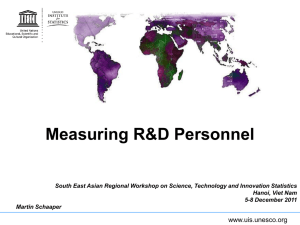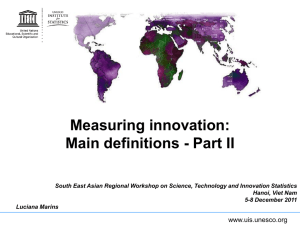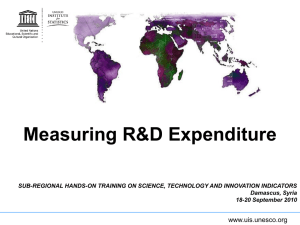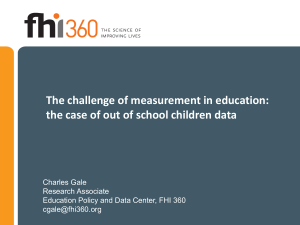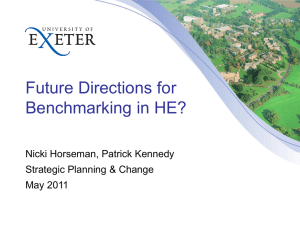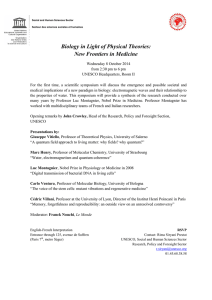FTE
advertisement
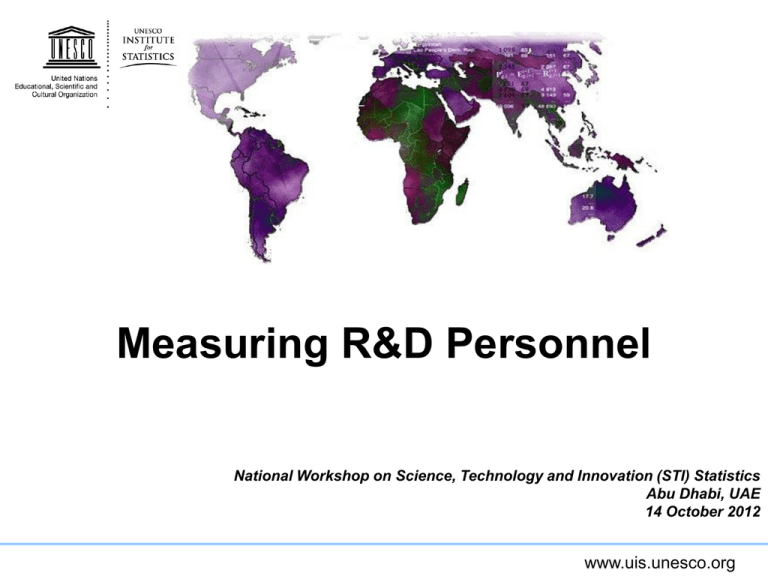
Measuring R&D Personnel National Workshop on Science, Technology and Innovation (STI) Statistics Abu Dhabi, UAE 14 October 2012 www.uis.unesco.org Frascati Manual deals with “input indicators” R&D Personnel • All persons employed directly on R&D, as well as those providing direct services such as R&D managers, administrators, and clerical staff R&D Expenditure • Will be the subject of a separate presentation Both inputs are necessary to secure an adequate representation of the effort devoted to R&D www.uis.unesco.org Classification by occupation R&D Personnel consist of: Researchers Technicians and equivalent staff Other supporting staff www.uis.unesco.org Researchers Researchers are professionals engaged in the conception or creation of new knowledge, products, processes, methods and systems and also in the management of the projects concerned www.uis.unesco.org Researchers (contd.) Includes managers and administrators engaged in the planning and management of the scientific and technical aspects of research Postgraduate students at the PhD level engaged in R&D should be considered as researchers www.uis.unesco.org Technicians and equivalent staff Technicians whose main tasks require technical knowledge and experience perform scientific and technical tasks involving the application of concepts and operational methods, normally under the supervision of researchers Equivalent staff perform the corresponding R&D tasks under the supervision of researchers in the social sciences and humanities www.uis.unesco.org Technicians and equivalent staff (contd.) Their tasks include: • Bibliographic searches • Preparing computer programmes • Carrying out experiments, tests and analyses • Preparing materials and equipment for experiments, tests and analyses • Recording measurements, making calculations and preparing charts • Carrying out statistical surveys and interviews www.uis.unesco.org Other supporting staff Other supporting staff includes skilled and unskilled craftsmen, secretarial and clerical staff participating in R&D projects or directly associated with such projects. www.uis.unesco.org Other supporting staff (contd.) Managers and administrators dealing mainly with financial and personnel matters and general administration, insofar as their activities are a direct service to R&D Persons providing indirect services to R&D, such as security, cleaning, maintenance, canteen staff, etc. should be excluded www.uis.unesco.org Headcount data (HC) “Headcount (HC)” data are data on the total number of persons who are mainly or partially employed on R&D. Headcount data are the most appropriate measure for collecting additional information about R&D personnel, such as age, gender or national origin. www.uis.unesco.org Headcount data (HC) (contd.) Possible approaches and options • Number of persons engaged in R&D at a given date (e.g. end of period) • Average number of persons engaged in R&D during the (calendar) year • Total number of persons engaged in R&D during the (calendar) year www.uis.unesco.org Full-time equivalence (FTE) data R&D may be the primary function or maybe a secondary function It may also be a significant part-time activity (e.g. university teachers or postgraduate students) The number of persons engaged in R&D must, therefore, also be expressed in full-time equivalents on R&D activities FTE is the true measure of the volume of R&D www.uis.unesco.org FTE (contd.) One FTE may be thought of as one person-year 1 FTE is equal to 1 person working full-time on R&D for a period of 1 year, or more persons working part-time or for a shorter period, corresponding to one person-year. (Dedication to the employment: FT/PT) FTE = x (Portion of the year active on R&D) x (Time or portion spent on R&D) www.uis.unesco.org FTE (contd.) Examples: • A full time employee spending 100% of time on R&D during a year (1 x 1 x 1) = 1 FTE • A full time employee spending 30% of time on R&D during a year (1 x 1 x 0.3) = 0.3 FTE • A full time R&D worker who is spending 100% of time on R&D, is employed at an R&D institution only for six months (1 x 0.5 x 1) = 0.5 FTE www.uis.unesco.org FTE (contd.) • A full time employee spending 40% of time on R&D during half of the year (person is only active for 6 months per year) (1 x 0.5 x 0.4) = 0.2 FTE • A part-time employee (working 40% of a full time year) engaged only in R&D (spending 100% of time on R&D) during a year (0.4 x 1 x 1) = 0.4 FTE • A part-time employee (working 40% of a full time year) spending 60% of time on R&D during half of the year (person is only active for 6 months per year) (0.4 x 0.5 x 0.6) = 0.12 FTE • 20 full time employees spending 40% of time on R&D during a year 20 x (1 x 1 x 0.4) = 8 FTE www.uis.unesco.org HC and FTE calculation 4 HC 1 HC FT: > 90% 1 FTE 1 HC 1 HC PT: 60% PT: 40% 0.6 FTE 0.4 FTE 1 HC SPT: 20% 0.2 FTE 2.2 FTE FT: Full time; PT: Part time; SPT: Significantly Part time www.uis.unesco.org Methods for calculating FTE FTE during a period is the most appropriate Other options • FTEs based on the average hours worked per week • FTEs devoted to each activity per week • FTE on a fixed date (ignores seasonal variations in R&D employment) Diversity of methods and the need for disclosure of method used • Different methods are used by different countries and sectors • Details of the methods employed should be made public www.uis.unesco.org FTE - Specific problems in the higher education sector Definition of working time of an academic teacher/researcher Teaching hours usually well-defined, but absolute working time varies: • Number of teaching hours per week • Demands made by examinations and student supervision • Administrative duties • Nature of R&D activities and deadlines imposed • Student vacation periods much of their professional activity – notably R&D – is carried out outside “normal working hours”. Calculation of full-time equivalence Must be based on total working time; No person can represent more than one FTE in any year and hence cannot perform more than one FTE on R&D. www.uis.unesco.org FTE: sources Time-use surveys: (repeat every 5-6 years) (a) Based on researchers’ own evaluation of the distribution of their working time (on average over a whole year); Examples; with two categories: “research” and “other activities” or with more categories: – Undergraduate teaching time: …% – Postgraduate course-work time: …% – Postgraduate research time: …% – Personal research time: …% – Administration: …% – Examinations: …% – Student counseling: …% – Unallocable internal time: …% – External professional time: …% – Total 100% www.uis.unesco.org FTE: sources (contd.) (b) Based on estimates by the heads of university departments or institutes • Aggregate survey: Full-time / part-time / 50% of time / 30% of time / etc • Cheaper method, less heavy burden on respondents • Questionnaires usually addressed to the head of the institute www.uis.unesco.org FTE: sources (contd.) R&D coefficients Non-survey-based coefficients derived from informed guesses to sophisticated models Sources of information Employment contracts Job descriptions Internal planning or evaluation tools Other countries’ coefficients Research grants given to different institutions S&T publications Accuracy of the coefficients depends on the quality of judgement. www.uis.unesco.org FTE & R&D Expenditure (GERD) FTE is key to adequately calculating GERD Researcher’s salaries are a significant part of GERD GERD should only include the proportion of the salaries devoted to R&D, i.e. FTE R&D salaries Including HC salaries would lead to significantly overestimated GERD www.uis.unesco.org Counting researchers – issues (1) Underestimation of researchers Unpaid research Informal research Research outside of the normal work setting with external funding Multiple part time positions not taken into account or undercounted Master’s research www.uis.unesco.org Counting researchers – issues (2) Overestimation of researchers Counting the contract instead of the real effort Multiple full-time research positions Special cases FTE calculation >1 and FTE>HC R&D in times of crisis Visiting researchers Brain circulation www.uis.unesco.org Counting researchers – issues (3) Recommendations Peer interviews of researchers Include a module on barriers Use secondary sources • Publication databases, both national and international • STMIS and other databases of researchers • Databases and registers of clinical trials • Databases and registers of the main foreign donors involved in funding R&D in the countries • University accreditation databases www.uis.unesco.org Summary R&D Personnel • Researchers, Technicians and equivalent staff, Other supporting staff Measurement • Headcount (HC) data • Full-time equivalence (FTE) data » Time-use surveys » Methods based on estimates by heads of university institutes » R&D coefficients www.uis.unesco.org Thank you! http://www.uis.unesco.org m.schaaper@unesco.org www.uis.unesco.org

